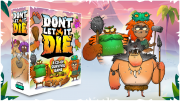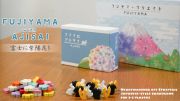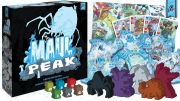Don't Let It Die (Sam Milham) – A cooperative survival game, players are working together to survive fourteen rounds while also trying to make discoveries, leading to the understanding of fire. Each round is divided into three phases. During the first phase, players can add wood to the fire to keep it burning, spend fire points to make discoveries, and eat food to regain health. You can also spend stamina to perform actions such as cooking food, drawing resource cards from decks, roll the fire die to gain fire points, or spending resources to craft items. The range of items you can craft increases as you make more discoveries. Next, the night phase occurs. Players draw an event card, which presents a challenge to overcome. Finally during the morning phase, wood is removed from the fire (if it ever goes out you lose the game), characters take damage (if all characters reach zero health you lose the game), stamina is reset, and a new round begins.
Casual Games on Kickstarter: Discover Fire, Defeat Guardians, and Slay Kaiju

This month’s Kickstarters will pit you against giant guardians, destruction-mad kaijus, and prehistoric dangers. But if you’re looking for something a little more laid back theme, there’s also some tricky golf, bird watching, flower growing, and an abstract tile-laying game.
Table Golf Association (John Garcia) – There are twenty-five double-sided terrain tiles that you can put together in a variety of ways to create the game board. Players then take turns flicking their golf ball from the start of the course to the end, avoiding hazards along the way, with each hazard having a different action that occurs when you hit it, often determining which fingers you can use next turn when flicking the golf ball.
Fujiyama with Ajisai (Nanatsumu) – This is a campaign for two games. In Fujiyama, players draft tiles and play tiles to their boards, making matches between tile edges and placing animal tokens. There are four different seasons represented across the tiles, and each one scores differently. For example, spring sections score based on the number of cherry blossom symbols shown, while autumn scores based on sets of the symbols that occur on autumn tiles. The unique twist of the game is, however, that you don’t draft your own hand, and instead you give the tiles you draft to the players on your left and right. In Ajishai there are seven different colors of flowers. Each player controls different colors, and when a new colored flower is added to the board, it influences the colors of the flowers already there. The player who has placed the most flowers of a certain color by the end of the game is the winner.
Maul Peak (Pencil First Games) – A standalone sequel to Skulk Hollow, in this asymmetrical two player game, one person takes on the role of a tribe of bears while the other player controls a colossal guardian. The bears must traverse around the board, to reach the guardian and climb onto it (represented by a separate board) attempting to deal damage across multiple areas on that guardian board. Meanwhile the guardian wins by defeating all the bears. The game can be mixed and matched with Skulk Hollow, or fully combined to increase the player count to three or four players.
Birds of a Feather: Western North America (Snowbright Studio) – Each turn, players simultaneously choose one card to play, and then all are revealed at the same time. You then mark off each bird that you see on your score sheet. You’re able to see the bird you played and any bird currently on the table (this includes those played this round as well as those played on the proceeding round) that are in the same habitat as your played bird. However, if a raptor card is played, it immediately discards all other birds in the same habitat that are still on the table. There are seven different types of birds in each habitat, worth different number of points for being seeing. If you manage to see all the birds in a habitat it is worth extra points at the end of the game.
Kaikoro (RAWR! Games) – A roll-and-write print-and-play game, Kaikoro is about defeating kaijus. There are five different kaijus to defeat on your player sheet. All players take turns simultaneously. You roll three dice. The red die determines which two kaijus on your sheet you can attack, and the two black dice are the numbers you use to attack them. Each kaiju is damaged in different, unique ways, and each kaiju will also grant you resources when you hit it — which can be used to do things such as change the value of your dice, increase your city's defenses, or allow you to attack other kaijus. After all players have resolved their attacks, you roll the red die again which determines which two kaijus will advance towards your city. If a kaiju is already in the city when it's triggered then it will damage it. If your city is destroyed, you are out of the game.
Sayū (Khanat Sadomwattana) – The game is made up of forty-nine two-sided tiles. Each side has three colored arrows spread out around the edges, and one single white arrow in the center. At the start of the game, the home tile is placed in the middle of the table. During the game, no tile can be placed farther than three tiles away from the home tile. On your turn you must choose a tile and place it on the board, with your player color face up. You are trying to flip your opponent’s tiles. To flip a tile, one of your colored arrows must point towards an opponent’s tile, while that tile must not be pointing back at your tile with its own colored arrow. Additionally, the white arrows on the two tiles cannot be pointed in the same direction. Once a tile is flipped, you then check to see if it in turn flips another tile, and so on until all flips have been resolved. It is now the next player’s turn.
Disclosure: unless otherwise noted, we have not seen or played any of the above games. Our assessment of each is based on the information given on the crowdfunding project page.











